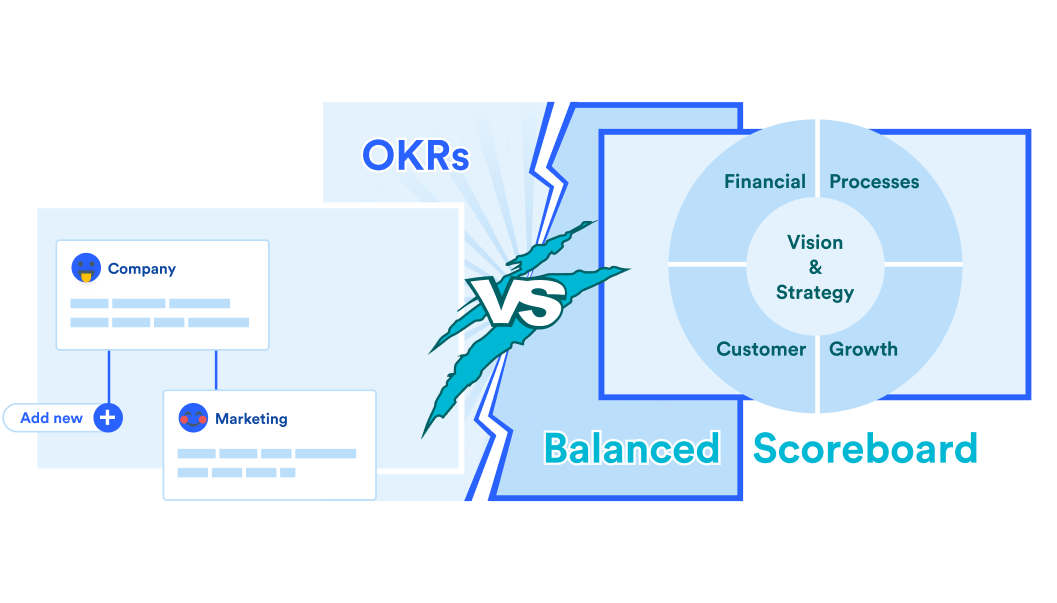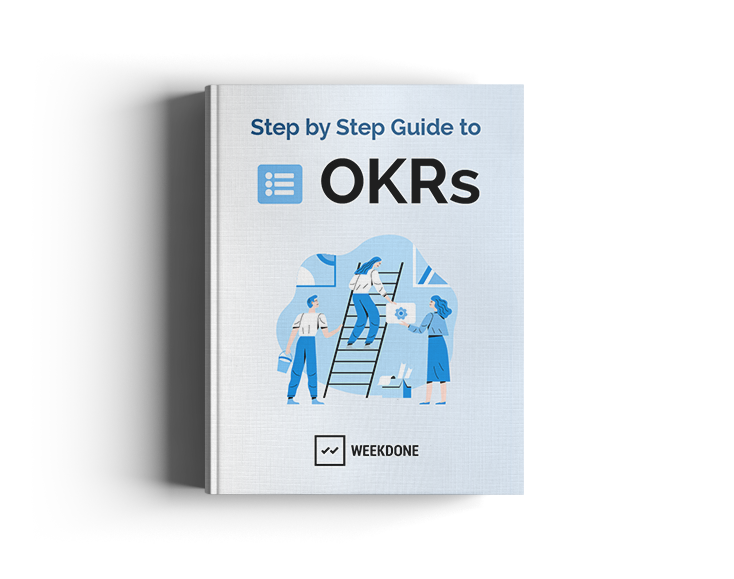Today’s business environment demands a company’s attention to efficiency and efficacy. While this makes sense, it creates challenges for businesses that they have yet to experience.
However, performance management methodologies give rise to change in uncertain times and help business managers forge ahead. The good news is that there are multiple options available from which companies can select. Carefully evaluating your needs is a great way to kick off the process in deciding which performance management system you may deploy.
The diverse management tools available support the efforts of teams from the top down in any organization. In this article, we examine two models that assist in this capacity: OKRs and the Balanced Scorecard.

Try OKR Software 🎯
Set and track OKRs in Weekdone OKR software with built-in examples, guided OKR Wizard, color-coded tracking, and visual dashboards. Stay focused – achieve goals.
What is Balanced Scorecard?
The Balanced Scorecard (BSC) links projects and processes together in a way that measures performance from four different perspectives. It combines elements of strategy such as milestones and project completion as opposed to OKRs which focus on operational efforts.
The BSC offers leeway and flexibility to teams that use it. It encourages accountability and assigns teamwork evenly. With the Balanced Scorecard managers can:
- unify projects with objectives
- evaluate KPS in a qualitative format
- adjust the plan as needed
Companies that use the BSC appreciate its overall approach to strategy. The most significant disadvantage of the BSC is the buy-in must occur across the entire organization, or its efficacy diminishes and never takes off companywide.
What are OKRs?
The Objectives and Key Results methodology (OKR) is a framework that seeks to establish a few goals, typically between 3 to 5 and then assigns Key Results to measure and determine success by analyzing the achievement of outcomes. Every task and goal requires teams to quantify their results. The goals you choose to prioritize are up to you.
OKRs are hierarchical. Employees set the first level of goals and progress upward through the ranks. The idea is that when employees achieve their goals then managers achieve theirs from bottom up.
In practice, OKRs measure performance by percentage with the maximum level of performance being 100. So, for example, if you have to ship 80 orders in a month, but you could only send 60, then your return is 75 percent. Consistent performance rewards tie in with increased compensation, benefits, and bonuses for workers who consistently produce high-quality work.
Try OKR Software 🎯
Set and track OKRs in Weekdone OKR software with built-in examples, guided OKR Wizard, color-coded tracking, and visual dashboards. Stay focused – achieve goals.
OKR vs Balanced Scorecard
As you can see, both frameworks have several similarities. However, there are characteristic differences between the two styles.
Here are 5 ways in which the BSC and OKR differ.
1. Clarifies results
The BSC is a little better at conveying results. Some managers find the results to be more accurate among BSC-operated projects. When it’s easier to read objectives, it may be more conducive to managing projects. Plus, it allows you to take insight and put it into action after recognizing the opportunities available.
2. Measures cadence
OKR performance reviews occur more frequently. BSC functions on an annual review basis. OKRs work weekly, monthly, and quarterly, in addition to annually. Due to our rapidly changing environment, OKRs make sense for today’s needs. Doing so give organizations the chance to correct its course before going too far ahead in the opposite direction.
3. Company-wide adoption
OKRs, by nature, implement tactics in both breadth and depth across an entire organization. OKRs give teams more flexibility in designing their objectives. This allowance provides them with stability in terms of engagement and participation. BSC focuses on top-down leadership styles which are bit counter-intuitive for younger companies and some industries.
4. Compensation
OKRs do not link themselves to compensation amounts directly. They focus on performance and excellence instead. While companies that use OKRs reward high performers handsomely, it is done based on achieving quantifiable goals. The BSC is more traditional in the sense that it still ties performance to pay and bonuses even if only partial.
5. Focus and aspiration
OKRs require companies to shift their focus to ambitious goals. In reality, it requires a willingness to fail in some ways. Instead of developing a list of practical objectives, OKRs encourage high-reaching, inspirational goals instead ones that employees know they can reach. In OKR, it’s reasonable never to reach 100 percent. Too high of a performance rating signals that the goals aren’t lofty or visionary enough.
3 Implementation Principles
No matter which option you choose, there are common threads that define success. First, executive leadership must participate in a performance management system to work. When they buy-in, everyone else follows suit and adopts an approach that promotes accountability.
Second, you must communicate the company’s ‘why’ to implement a performance management system to support your efforts. When employees understand the need for a new framework, then the process to adopt it is more fluid.
Finally, it’s essential to culturally align with the framework you choose. This decision isn’t one that managers and business owners make overnight. Instead, it takes time and patience before the implementation feels ‘natural.’
Final Thoughts on BSC and OKRs
The correct implementation of either BSCs and OKRs can transform an organization by turning planning into action. Choosing the right tool depends on the needs of your organization.
However, the universal message is clear: don’t leave your strategic efforts on the back burner by putting them on the shelf. Use performance management strategies to amplify your efforts.
Free Download: Step by Step Guide to OKRs

OKRs are not the easiest methodology to pick up, as countless articles and books out there would have you believe. Most books on the subject start by highlighting how they can revolutionize your company and boost productivity across your entire company, but they don’t give you much info on how to actually go about it.
How can Weekdone help your company?
Weekdone is your OKR-based solution to help you meet your goals, align teams with the company vision, strategize and think deeper, as well as implement weekly planning sessions and quarterly reviews.
We take company-wide goal management to the next level by offering easy-to-track activity options so your teams can connect with each other daily, regardless of what department they’re in!
Want to learn more about meeting your objectives? Check out our case studies to find out why OKRs work and how Weekdone can help you manage them more effectively.
Free 14 day trial for everyone. Teams of 3 or less use Weekdone free forever (all features included) Check out further pricing details to implement OKR software in your company today!